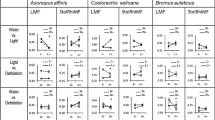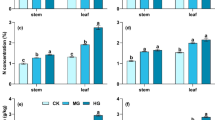Abstract
Resource availability is an important factor affecting the capacity of compensatory growth after grazing. We performed a greenhouse experiment with Poa bulbosa, a small perennial grass of the Mediterranean and Central Asian grasslands, to test the importance of nutrient availability for compensatory growth after clipping. We also compared the results with predictions of the limited resource model (LRM). Plants were grown at low and high fertilization levels and subjected to a clipping treatment. Contrary to the LMR, we found that in Poa plants compensatory growth occurred under the high fertilization level, while it did not occur under the low level. The LMR predicts a higher tolerance for grazing in the stressful environment. Our plants showed a significant decrease in their relative growth rates (RGR) after clipping. Although the plants allocated a 32–188% greater fraction of the mass to lamina growth after clipping, this greater allocation to the leaves did not fully compensate for the initial reduction in leaf area ratio (LAR). A sensitivity analysis showed for the clipped plants under the high fertilization treatment, that changes in leaf allocation (f lam) enabled the plants to compensate for a part of the potential loss caused by defoliation. Probably, the increased biomass allocation comes largely from the bulbs. We conclude that the inconsistency of the LRM with our results originates in the lack of compensatory mechanisms in the model. To better understand how environmental conditions affect tolerance to herbivory, the effects of compensatory growth should be taken into account.




Similar content being viewed by others
References
Anten NPR, Ackerly DD (2001a) Canopy-level photosynthetic compensation after defoliation in a tropical understorey palm. Funct Ecol 15:252–262
Anten NPR, Ackerly DD (2001b) A new method of growth analysis for plants that experience periodic losses of leaf mass. Funct Ecol 15:804–811
Anten NPR, Martinez-Ramos M, Ackerly DD (2003) Defoliation and growth in an understory palm: quantifying the contributions of compensatory responses. Ecology 84:2905–2918
Belsky AJ, Carson WP, Jensen CL, Fox GA (1993) Overcompensation by plants: herbivore optimization or red herring? Evol Ecol 7:109–121
Chapin FS III, Schulze ED, Mooney HA (1990) The ecology and economics of storage in plants. Ann Rev Ecol Syst 21:423–427
Coughenour MB, Detling JK, Bamberg IE, Mugambi MM (1990) Production and nitrogen responses of the African dwarf shrub Indigofera spinosa to defoliation and water limitation. Oecologia 83:546–552
Detling JK (1998) Mammalian herbivores: ecosystem-level effects in two grassland national parks. Wildl Soc Bull 26:438–448
Evans JR (1989) Photosynthesis and nitrogen relationships in leaves of C3 plants. Oecologia 78:9–19
Gold WG, Caldwell MM (1990) The effects of the spatial pattern of defoliation on regrowth of a tussock grass III. Photosynthesis, canopy structure and light interception. Oecologia 82:12–17
Hilbert DW, Swift DM, Detling JK, Dyer MI (1981) Relative growth rates and the grazing optimization hypothesis. Oecologia 51:14–18
Holland EA, Parton WJ, Detling JK, Coppock DL (1992) Physiological responses of plant populations to herbivory and their consequences for ecosystem nutrient flow. Am Nat 140:685–706
Kobe RK (1997) Carbohydrate allocation to storage as a basis of interspecific variation in sapling survivorship and growth. Oikos 80:226–233
Ladero M (1992) Los majadales de la clase Poetea bulbosae: manejo y sistemática. In: AEFA (eds) Actas XII Jornadas de Fitososciologia. Oviedo, pp 17–20
Martinez-Ramos M, Anten NPR, Ackerly DD (2009) Defoliation and ENSO effects on vital rates of an understorey tropical rain forest palm. J Ecol 97:1050–1061
McNaughton SJ (1983) Compensatory plant growth as a response to herbivory. Oikos 40:329–336
Nowak RS, Caldwell MM (1984) A test of compensatory photosynthesis in the field: implications for herbivory tolerance. Oecologia 61:311–318
Oesterheld M, McNaughton SJ (1991) Effect of stress and time for recovery on the amount of compensatory growth after grazing. Oecologia 85:305–313
Ofir M, Kigel J (1999) Photothermal control of the imposition of summer dormancy in Poa bulbosa, a perennial grass geophyte. Physiol Plant 105:633–640
Peco B, Sanchez AM, Azcarate FM (2006) Abandonment in grazing systems: consequences for vegetation and soil. Agric Ecosyst Environ 113:284–294
Rivas-Martinez S, Fernandez Gonzalez F, Loidi J, Lousa M, Penas A (2001) Syntaxonomical checklist of vascular plant communities of Spain and Portugal to Alliance level. Itinera Geobot 14:5–341
San Miguel A (2001) Pastos naturales españoles. Fundación Conde del Valle de Salazar. Mundi-Prensa, Spain
Van der Graaf AJ, Stahl J, Bakker JP (2005) Compensatory growth of Festuca rubra after grazing: can migratory herbivores increase their own harvest during staging? Funct Ecol 19:961–969
Van der Heyden F, Stock WD (1996) Regrowth of a semiarid shrub following simulated browsing: the role of reserve carbon. Funct Ecol 10:647–653
Van Staalduinen MA (2005) The impact of herbivores in a Mongolian forest steppe. PhD-thesis, Utrecht University, Utrecht, The Netherlands
Van Staalduinen MA, Anten NPR (2005) Difference in the capacity for compensatory growth of two co-occurring grass species in relation to water availability. Oecologia 146:190–199
Van Staalduinen MA, During HJ, Werger MJA (2007) Impact of grazing regime on a Mongolian forest steppe. Appl Veg Sci 10:299–306
Van Wieren SE (1987) Het grazende dier. In: De Bie S, Joenje W, Van Wieren SE (eds) Begrazing in de Natuur. Pudoc Wageningen, The Netherlands, pp 34–53
Wise MJ, Abrahamson WG (2007) Effects of resource availability on tolerance of herbivory: a review and assessment of three opposing models. Am Nat 169:443–454
Acknowledgments
We kindly thank Marinus Werger and Henri Noordman for the chemical analyses of the plant samples at the Plant Ecology & Biodiversity group, Utrecht University, The Netherlands, and Niels Anten for his fruitful comments on the manuscript. We acknowledge the financial support to Marja van Staalduinen from the REMEDINAL Program financed by CAM(S-0505/AMB/0335) and the Stichting Fonds Doctor Catharine van Tussenbroek. We also wish to acknowledge the partial financial support provided by the CICYT project (CGL2007-63382).
Author information
Authors and Affiliations
Corresponding author
Rights and permissions
About this article
Cite this article
van Staalduinen, M.A., Dobarro, I. & Peco, B. Interactive effects of clipping and nutrient availability on the compensatory growth of a grass species. Plant Ecol 208, 55–64 (2010). https://doi.org/10.1007/s11258-009-9686-0
Received:
Accepted:
Published:
Issue Date:
DOI: https://doi.org/10.1007/s11258-009-9686-0




